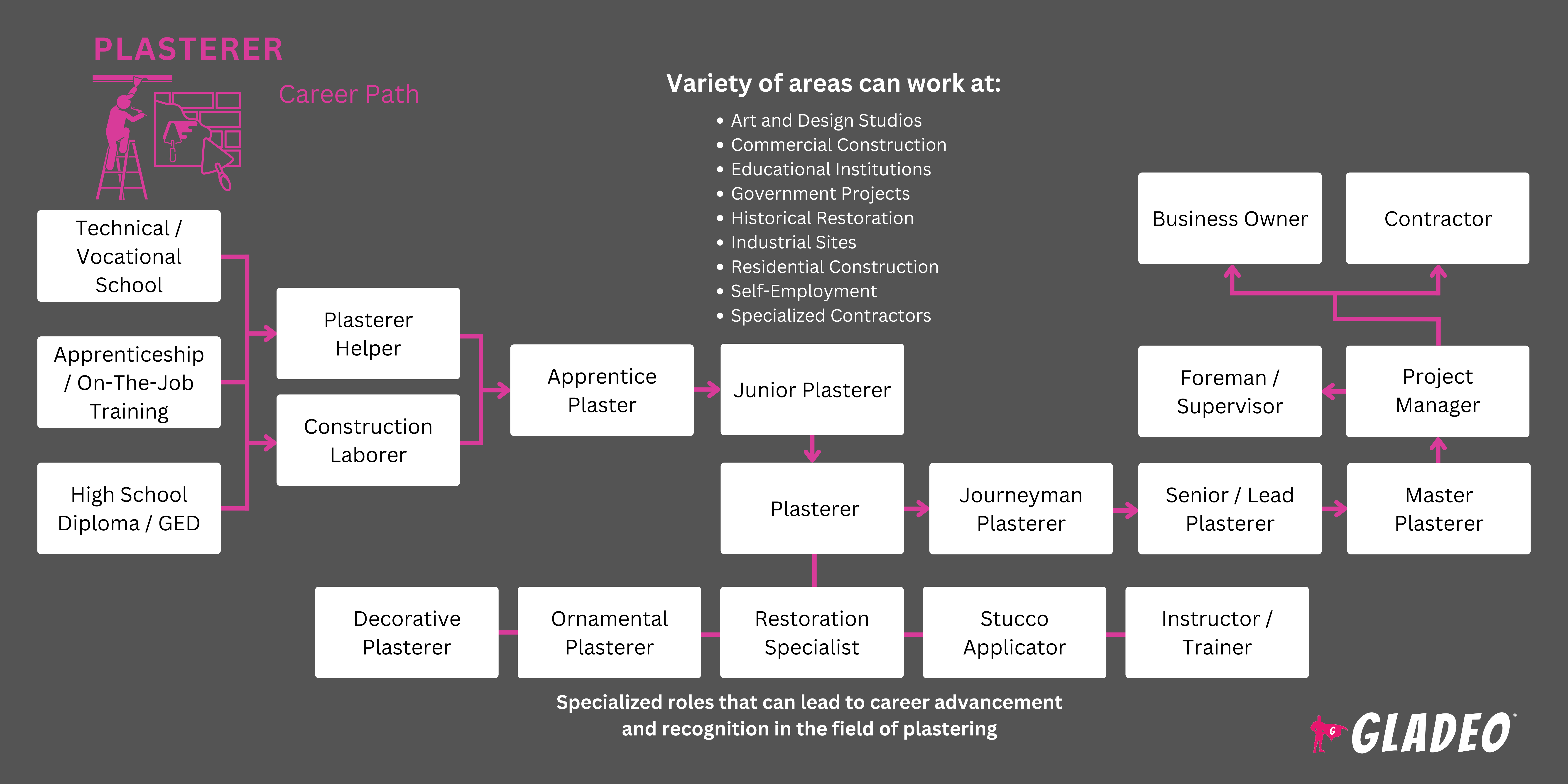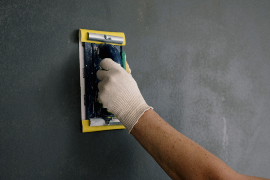Focos de atención
Aplicador, Escayolista artesano, Escayolista y estucador, Aplicador de escayola, Mecánico de escayola, Escayolista, Oficial de escayolista, Contratista de escayolistas
These days, the walls and ceilings of most modern homes are made from an inexpensive material called drywall. However, a lot of older homes – and many home builders today – use plaster. Plaster for homes can be made from gypsum, lime, cement, clay, or decorative Venetian mixtures. It’s labor-intensive and expensive to install, but also durable and able to be shaped to form intricate designs and custom textures!
Plasterers are the skilled tradespeople who apply coats of plaster (and in some cases stucco or similar materials) to interior and exterior surfaces to create smooth, textured, or decorative finishes. The plaster is typically applied over a lath – a base layer of wood, metal, or gypsum surface that the plaster can adhere to. For instance, wood laths are narrow wooden strips nailed horizontally, metal laths are sheets of expanded or woven mesh, and gypsum (or rock) laths come in large rigid panels.
Plasterers can be found working on new construction, renovations, and historical restorations, contributing to the durability and aesthetic appeal of buildings. They also repair and restore damaged plasterwork, install insulation materials, and sometimes cast and install decorative elements like cornices and moldings. The job requires precision, patience, technical expertise, and a keen eye for detail!
- Enhancing the structural integrity and appearance of buildings
- Working on a variety of projects, from new constructions to historical renovations
- Using a combination of artistic skills and technical knowledge
- Collaborating with a range of professionals in the construction industry
Horario de trabajo
Plasterers typically work full-time, often on scaffolding or ladders. They may work evenings or weekends to meet deadlines during busy projects.
Tareas típicas
- Meet with clients or supervisors to discuss projects, timelines, budgets, materials, etc.
- Estimate and order the necessary material quantities.
- Gather materials, tools, and equipment. Transport everything to the job site.
- Prepare sites, working from blueprints, specifications, and written or verbal instructions.
- Set up scaffolding and ladders to access high walls and ceilings.
- Prepare and clean surfaces for plastering, ensuring they are free of dust, debris, or old materials.
- Measure and mark surfaces to ensure precise application of plaster materials.
- Install lath, wire mesh, or other materials to reinforce plaster applications. Cut lath materials, as necessary.
- Cut and install corner beads and trim to reinforce edges and create clean lines.
- Mix and apply coats of plaster, stucco, or other finishing materials using trowels, brushes, or spray equipment.
- Apply scratch and brown coats before finishing to ensure strong adhesion.
- Create smooth or decorative textures using specialized tools and techniques.
- Blend and tint plaster to match existing finishes or achieve desired colors.
- Apply waterproofing and insulation layers to improve energy efficiency and durability.
- Use hand and power tools to smooth, shape, and polish finished surfaces.
- Seal and prime plastered surfaces before painting or further finishing.
- Install and restore ornamental plasterwork, such as moldings and cornices.
- Repair cracks, holes, or damaged plaster on walls and ceilings.
- Remove and dispose of old plaster and debris.
- Coordinate with contractors, architects, and designers to meet project specifications.
- Follow safety regulations and guidelines to prevent injuries and ensure job site compliance.
Responsabilidades adicionales
- Protect surrounding surfaces and fixtures from plaster splatter or damage.
- Maintain and clean tools, equipment, and workspaces.
- Mix and apply specialty plasters, such as Venetian or fire-resistant coatings.
- Conduct moisture and structural assessments before plaster application.
- Train and supervise apprentices or less-experienced workers.
- Adapt plastering techniques for different climates and building materials.
- Follow strict safety protocols and wear protective gear, including masks and gloves.
- Collaborate with other construction professionals, such as carpenters, painters, and masons.
Habilidades blandas
- Adaptabilidad
- Atención al detalle
- Comunicación
- Creatividad
- Pensamiento crítico
- Destreza
- Coordinación mano-ojo
- Independencia
- Integridad
- Destreza manual
- Organización
- Paciencia
- Resistencia física
- Resolución de problemas
- Fiabilidad
- Safety awareness
- Spatial awareness
- Strength
- Trabajo en equipo
- Gestión del tiempo
Habilidades técnicas
Plasterers need technical skills and knowledge related to the following topics:
- Adhesive and bonding agent selection
- Application methods (hand troweling, spraying, floating)
- Lectura de planos
- Color blending and tinting
- Decorative plasterwork (moldings, cornices, sculptural designs)
- Finishing techniques (sanding, polishing, sealing)
- Fire-resistant and acoustic plaster application
- Insulation application
- Lath installation (wood, metal, gypsum)
- Material estimation and ordering
- Modeling programs like Blender, Autodesk 3ds Max, SketchUp, Rhino 3D, and ZBrush
- Moisture and substrate assessment
- Plaster mixing (lime, cement, gypsum, synthetic)
- Plastering techniques (smooth, textured, Venetian, stucco)
- Plastering tools (trowels, hawks, sprayers, floats)
- Reinforcement techniques (wire mesh, corner beads)
- Repair methods (patching, resurfacing, blending)
- Safety regulations (OSHA compliance)
- Scaffolding and ladder setup
- Scratch and brown coat application
- Surface preparation (cleaning, priming, bonding agents)
- Tool maintenance and sharpening
- Wall and ceiling restoration techniques
- Waterproofing techniques
- Residential and commercial construction companies
- Restoration and renovation firms
- Specialty plastering contractors
- Self-employment or small business ownership
- Government agencies for historical building preservation
Plasterers must maintain precision and attention to detail while doing repetitive tasks like mixing materials, applying coats, and smoothing surfaces. The job demands both strength and stamina to bend, kneel, and reach for long periods while they work.
A commitment to safety is crucial! There’s constant exposure to things like dust, chemical fumes, and adhesives, making it essential to wear proper protective equipment. In addition, the job often requires working at heights on scaffolding or ladders, so Plasterers have to be mindful of falling and other risks. Many projects are outside, so there can be weather hazards to deal with such as hot or cold temperatures or slippery conditions caused by rain.
Plasterers frequently work as independent contractors, in which cases they’ve always got to look for new projects. Work schedules vary based on deadlines, and overtime, weekends, and night shifts are not uncommon during busy seasons. On the flip side, there may be less work during winter months, so it’s vital to plan ahead and have a backup source of income, if needed.
Plastering demands continuous skill development to stay competitive. Mastering complex techniques, working with new materials, and keeping up with evolving construction standards requires an investment of unpaid study time, but the effort usually pays off!
The plastering industry is seeing a shift toward green building initiatives, which involves the use of eco-friendly, sustainable materials like non-toxic breathable coatings and natural materials versus synthetic products.
Advancements in tools and application methods are also transforming the trade, such as plaster spray application technology that allows for faster coverage while maintaining quality. The adoption of 3D modeling and virtual visualization programs like Blender, Autodesk 3ds Max, SketchUp, Rhino 3D, and ZBrush are allowing designers and clients to preview plasterwork before application, which greatly helps with planning and communications.
Historical restoration trends are causing increased demand for skilled Plasterers to preserve and replicate intricate designs found in heritage buildings, requiring a blend of traditional craftsmanship and modern techniques. In fact, decorative ornamental plastering is making a comeback in modern residential and commercial buildings, too, such as custom moldings, textured finishes, and artistic ceiling designs. This can be a lucrative market for those with the right skills!
Plasterers often enjoyed hands-on activities and creative projects from a young age. They might have been fascinated with building models, painting, sculpting, or other activities that required precision and attention to detail while working with physical objects.
- Plasterers usually need at least a high school diploma or GED. Most entry-level plastering jobs require workers to be at least 18 years old, but some apprenticeship or pre-apprenticeship programs accept 16-17 year olds with parental consent or as part of a vocational high school/career and technical education (CTE) program.
- Courses like math, blueprint reading, tool safety, material science, construction, or roofing techniques in high school, vocational school, trade school, or community college can be very helpful.
- Familiarity with modeling programs like Blender, Autodesk 3ds Max, SketchUp, Rhino 3D, and ZBrush is also an advantage.
- Applicants may be required to have a valid driver’s license so they can drive to work sites. In some instances, a commercial driver’s license (CDL) may be required.
- Most aspiring Plasterers start as helpers, receiving on-the-job training sometimes via sponsored apprenticeships, such as:
- The Operative Plasterers’ and Cement Masons’ International Association’s International Training Fund’s Apprenticeship Program
- The National Plastering Industry’s Joint Apprenticeship Trust Fund
- Employers may require new workers to complete Occupational Safety and Health Administration safety (OSHA) training or GAF CARE Contractor Training Center courses.
- Note, many states require Plasterers to obtain a license at some point in their careers. Licensing options may include a residential license, a commercial license, or a combination license.
- To qualify for licensure, Plasterers must a) pass a trade exam and b) show proof of a minimum number of completed projects.
- Other possible licensure requirements include liability insurance coverage and a surety bond.
- Experienced Plasterers can apply for certification from the National Roofing Contractors Association PROCertification program.
- Otras certificaciones incluyen la de Consultor Registrado de Cubiertas del Instituto Internacional de Consultores de Cerramientos de Edificios.
- Note, construction employers and apprenticeships may require pre-employment substance testing.
- Consider apprenticeship opportunities as well as formal classroom training options.
- For training programs, look at the cost of tuition, discounts, and local scholarship availability (in addition to federal aid).
Some high schools may offer pre-apprenticeship or CTE programs to prepare students ahead of time. - Piensa en tu horario y flexibilidad a la hora de decidir si te matriculas en un programa presencial, en línea o híbrido. Necesitarás tanta práctica como puedas conseguir.
- Look closely at the program’s facilities and equipment to ensure they are modern and high quality. Check out the program’s faculty awards and accomplishments.
- Ideally, programs should cover safety training and offer opportunities to specialize in decorative plastering or stucco application.
- Consulta las estadísticas de colocación y los detalles sobre la red de antiguos alumnos del programa.
Students can take applicable courses or join training programs at local trade schools and community colleges. In addition, many industry associations and unions offer apprenticeship programs where new Plasterers can learn while they work and get paid!
For example, the Operative Plasterers’ and Cement Masons’ International Association’s International Training Fund’s Apprenticeship Program combines on-the-job training with classroom instruction, covering various aspects of plastering and cement masonry.
In partnership with Job Corps, the National Plastering Industry’s Joint Apprenticeship Trust Fund provides a pre-apprenticeship program designed for youth aged 16 to 24. This program offers hands-on training in plastering, preparing students for entry into formal apprenticeship programs.
- In high school, community college, or vocational school, take relevant courses such as English, general math (arithmetic, fractions, decimals, ratios, proportions), geometry, physics, blueprint reading, and drafting.
- Apply to participate in pre-apprenticeship programs as part of a vocational high school/career and technical education (CTE) program. Any construction, plastering, woodworking, or shop classes will also be beneficial!
- Learn to safely use hand and power tools under the supervision of a professional tradesperson, either in classes or by volunteering or part-time jobs.
- Read plastering-related books, trade magazines, and blogs, and watch video tutorials like Plastering For Beginners or On the Trowel.
- Try to do an informational interview with a working Plasterer to learn about the job, the training, and how to get hired.
- Research entry-level positions or apprenticeships with local contractors.
- Practice plastering techniques on small home projects, such as repairing drywall, applying stucco, or experimenting with different textures.
- Make a portfolio of your completed projects to showcase your skills.
- Keep in mind that construction employers and apprenticeships may require pre-employment substance testing for safety compliance.
Some may also require a driver’s license.

- Look for apprenticeship opportunities at Apprenticeship.gov and local unions.
- Si solicita un aprendizaje sindical, lea atentamente las instrucciones de la solicitud antes de rellenar nada
- No te limites a escribir las respuestas a las preguntas directamente en un sitio web. Escríbelas en un documento aparte, así podrás corregirlas ortográficamente con más facilidad y guardarlas para utilizarlas en otro sitio.
- There may be basic exams to test your knowledge, however, “most unions don’t expect you to be an expert in your industry at this point,” notes Indeed.
- You can take practice exams to find areas where you might need to study more.
- If your application is accepted, there will generally be an apprenticeship interview, so plan ahead by reading potential questions and preparing your answers.
- Check sites like Indeed, SimplyHired, Glassdoor, and Craiglist for openings.
- Review job ads to ensure you meet the listed requirements.
- For example, if a driver's license is required, make sure you have it before applying. If it's listed as preferred, mention if you're in the process of obtaining it.
- Create a strong resume that highlights relevant work experience, training, and skills. Use plastering-related keywords like:
- Drywall finishing
- Lath installation
- Ornamental plastering
- Plastering techniques
- Safety compliance
- Skim coating
- Stucco application
- Surface preparation
- Texture matching
- Trowel work
- Review Plasterer resume templates to get ideas for formatting and phrasing.
- Research common Plasterer interview questions and practice answering them.
- Ask your school’s career services for help with resumes, mock interviews, and job searches. They may have connections to unions offering apprenticeships.
- Reach out to your network and let them know you’re looking for opportunities.
- Engage in online forums to ask career advice questions.
- Ask professors, supervisors, or peers if they’ll serve as personal references. Get their permission before giving out their contact information.
- Dress appropriately and maintain professional communication during job interviews.
- Keep your social media presence professional, because employers look you up online.
- Get licensed, if required by your state and once you meet the qualifications!
- Demonstrate leadership by doing consistently high-quality work, being on-site on time, collaborating effectively with team members, and finishing projects on time and within budget.
- Prioriza siempre la seguridad y nunca tomes atajos. Un percance o lesión importante podría dañar toda tu carrera.
- Talk to your supervisor about your career goals. Offer to complete additional training they suggest, such as advanced or specialized certifications.
- Challenge yourself to work on more complex projects. Continue to learn about aesthetics and structural principles.
- Stay up-to-date on modeling software and green methods.
- Take courses in project management to handle larger projects and manage budgets, timelines, and personnel. Acquire skills in estimating costs and bidding.
- Cree una cartera profesional en la que muestre sus mejores trabajos, los testimonios de sus clientes y su historial de seguridad.
- Si es necesario para ascender, solicite trabajo en organizaciones más grandes que puedan tener más posibilidades de progresar, o ponga en marcha su propio negocio.
Páginas web
- Aprendizaje.gov
- Constructores y Contratistas Asociados
- Contratistas Generales Asociados de América
- Unir las oportunidades excepcionales con las competencias de las artesanas
- Conexiones profesionales
- GAF
- De los cascos a los cascos protectores
- Instituto de Constructores de Viviendas
- Sindicato Internacional de Albañiles y Oficios Conexos
- Cuerpo de Trabajo
- Asociación Nacional de Constructores de Viviendas
- Asociación Nacional de la Industria de la Remodelación
- Sindicato Nacional de la Construcción
- National Plastering Industry’s Joint Apprenticeship Trust Fund
- Asociación Nacional de Contratistas de Tejados
- Centro Nacional de Educación e Investigación de la Construcción (NCCER)
- Administración de Seguridad y Salud en el Trabajo
- Asociación Internacional de Yeseros y Albañiles del Cemento
Libros
- Plaster and Plastering; Mortars and Cements, How to Make, and How to Use, by Frederick Thomas Hodgson
- Plastering, Plain and Decorative, by William Millar
- Plastering Skills, by F. Van Den Branden and Thomas L. Hartsell
- The Natural Plaster Book: Earth, Lime, and Gypsum Plasters for Natural Homes, by Cedar Rose Guelberth and Dan Chiras
Plasterers are vital members of the construction industry, but plaster can be a challenge to mix and work with! For those considering different types of hands-on jobs, see our list of related careers below!
- Carpintero
- Instalador de baldosas de techo
- Inspector de construcción y edificación
- Obrero de la construcción
- Instalador de paneles de yeso
- Electricista
- EV Charging Station Installer
- Instalador de suelos
- Acabador de muebles
- Obrero de mantenimiento general y reparaciones
- Técnico de HVAC
- Aislador
- Albañil
- Creador de modelos
- Pintor
- Techador
- Trabajador de chapa metálica
- Instalador de energía solar fotovoltaica
- Fabricante e instalador de estructuras metálicas
- Colocador de azulejos y piedra
- Soldador
- Montador, operador y operario de máquinas para trabajar la madera
Newsfeed

Trabajos destacados

Cursos y herramientas en línea






